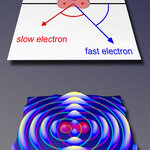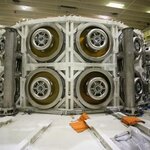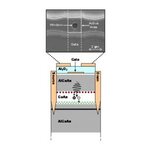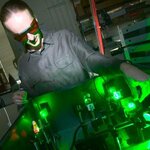Physics

A new antenna made of plasma (a gas heated to the point that the electrons are ripped free of atoms and molecules) works just like conventional metal antennas, except that it vanishes when you turn it off.
That's important on the battlefield and in other applications where antennas need to be kept out of sight. In addition, unlike metal antennas, the electrical characteristics of a plasma antenna can be rapidly adjusted to counteract signal jamming attempts.
Plasma antennas behave much like solid metal antennas because electrons flow freely in the hot gas, just as they do in metal…

The big world of classical physics mostly seems sensible: waves are waves and particles are particles, and the moon rises whether anyone watches or not. The tiny quantum world is different: particles are waves (and vice versa), and quantum systems remain in a state of multiple possibilities until they are measured -- which amounts to an intrusion by an observer from the big world -- and forced to choose: the exact position or momentum of an electron, say.
On what scale do the quantum world and the classical world begin to cross into each other? How big does an "observer" have to be? It's a…

An Israeli-Jordanian-U.S. cooperative project aimed at measuring air quality in the area between the neighboring southern cities of Aqaba in Jordan and Eilat in Israel has been launched by scientists from the Hebrew University of Jerusalem together with scientists from the Aqaba Special Economic Zone Administration (ASEZA) and the Desert Research Institute of Reno, Nevada, in the US.
The one-month, intensive, transboundary regional air quality research study began earlier this month, with the Israeli team operating a mobile laboratory located north of Eilat, and the Jordanian researchers…

Rutgers University physicists have performed computer simulations that show how electrons become one thousand times more massive in certain metal compounds when cooled to temperatures near absolute zero – the point where all motion ceases. The models may provide new clues as to how superconductivity works and how new superconducting materials could be fabricated.
In a paper posted to Science Express, the researchers describe how electrons interact with other particles in these compounds to morph into what physicists call a fluid of “heavy quasiparticles” or a “heavy fermion fluid.” While this…

The running joke in science has always been that the metric system was invented by the French to combat English predominance culturally - and they got the measurement wrong.
Still, it caught on ( though the French calendar didn't ) and that International System of Units (SI) is used on everything from beer cans to Olympic races. But some of it still isn't entirely accurate, as discussed in Making A More Accurate Kilogram ( along with that same poke at the French ) because man-made objects can change.
The English could have the last laugh. U.K. Scientists from the National Physical…

For almost 75 years, astronomers have believed that the Universe has a large amount of unseen or ‘dark’ matter, thought to make up about five-sixths of the matter in the cosmos. With the conventional theory of gravitation, based on Newton’s ideas and refined by Einstein 92 years ago, dark matter helps to explain the motion of galaxies, and clusters of galaxies, on the largest scales.
Now two Canadian researchers at the Perimeter Institute for Theoretical Physics suggest that the motion of galaxies in a distant cluster is more easily explained by a Modified Gravity (MOG) theory than by the…

Sandia National Laboratories’ Z machine, the world’s largest producer of X-rays, shook the ground for several hundred yards in every direction for the first time since July 2006, when the 22-year-old facility was gutted to undergo a complete refurbishment at a total project cost of $90 million.
Z has been overbooked in recent years with requests for experiment time from national labs, universities, and the international community. The facility is in demand because of Z’s capability to subject materials to immense pressures, compress spherical capsules to produce thermonuclear fusion reactions…

A transistor containing quantum dots that can count individual photons (the smallest particles of light) has been designed and demonstrated at the National Institute of Standards and Technology (NIST).
The semiconductor device could be integrated easily into electronics and may be able to operate at higher temperatures than other single-photon detectors—practical advantages for applications such as quantum key distribution (QKD) for “unbreakable” encryption using single photons.
The NIST device, described in a new paper(1) can accurately count 1, 2 or 3 photons at least 83 percent of the…

The Royal Swedish Academy of Sciences has decided to award the Nobel Prize in Physics for 2007 jointly to Albert Fert, Unité Mixte de Physique CNRS/THALES, Université Paris-Sud, Orsay, France, and Peter Grünberg, Forschungszentrum Jülich, Germany, "for the discovery of Giant Magnetoresistance".
Nanotechnology gives sensitive read-out heads for compact hard disks
This year's physics prize is awarded for the technology that is used to read data on hard disks. It is thanks to this technology that it has been possible to miniaturize hard disks so radically in recent years. Sensitive read-out…

Quantum dots have great promise as light-emitting materials, because the wavelength, or color, of light that the quantum dots give off can be very widely tuned simply by changing the size of the nanoparticles. If a single dot is observed under a microscope, it can be seen to randomly switch between bright and dark states. This flickering, or blinking, behavior has been widely studied, and it has been found that a single dot can blink off for times that can vary between microseconds and several minutes. The causes of the blinking, though, remain the subject of intense study.
In order to learn…